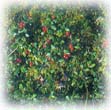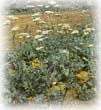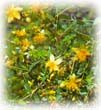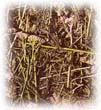Common burnet
 Perennial grassy plant. Stalk height is up to 20- 100 cm, stalks are ribbed, bare, straight- standing, hollow. Rootstocks are thick, horizontal, woody. Radical leaves are big, with long stems, pinnate, with 7- 25 leaflets; stalk leaves are cauline and grow smaller on the top. Leaflet’s length is 2,5- 6 cm, they are long and egg- shaped, saw- like, sometimes crenate. The upper side is dark green, shining; the lower side – blue- grey, lustreless. Flowers are dark- green or dark- purple, gathered into oval or oblong capitate racemes, which are set on long floriferous shoots. Fruits’ length is 3- 5 mm, they are dry, small, brown. Perennial grassy plant. Stalk height is up to 20- 100 cm, stalks are ribbed, bare, straight- standing, hollow. Rootstocks are thick, horizontal, woody. Radical leaves are big, with long stems, pinnate, with 7- 25 leaflets; stalk leaves are cauline and grow smaller on the top. Leaflet’s length is 2,5- 6 cm, they are long and egg- shaped, saw- like, sometimes crenate. The upper side is dark green, shining; the lower side – blue- grey, lustreless. Flowers are dark- green or dark- purple, gathered into oval or oblong capitate racemes, which are set on long floriferous shoots. Fruits’ length is 3- 5 mm, they are dry, small, brown.
|
 Small bush, up to 25 cm height, with creeping rootstock and straight standing branchy stalks. Leaves are orbicular, obovate or elliptical, almost whollyedged, a bit turned up by the edge. Leaf's upside is dark- green, shining, back side is light- green with brown spots. Flowers are gathered into shot drooping apical 4- 8 flowers racemes. Calyx is quadriparted, crown is like a bell, pink. Fruit is globe- shaped shiny, red juicy berry (after it ripened) with a lot of small seeds. Cowberry grows in pine and larch forests, in fir- woods. Sometimes it forms unbroken bushes.
Small bush, up to 25 cm height, with creeping rootstock and straight standing branchy stalks. Leaves are orbicular, obovate or elliptical, almost whollyedged, a bit turned up by the edge. Leaf's upside is dark- green, shining, back side is light- green with brown spots. Flowers are gathered into shot drooping apical 4- 8 flowers racemes. Calyx is quadriparted, crown is like a bell, pink. Fruit is globe- shaped shiny, red juicy berry (after it ripened) with a lot of small seeds. Cowberry grows in pine and larch forests, in fir- woods. Sometimes it forms unbroken bushes.
 Perrenial grassy plant, up to 2m height. Rootstock is shot, vertical, covered with a lot of adventitious roots, up to 20cm length. Stalk is straight standing, simple, branchy above, hollow, cylindrical, grooved, naked or fur- trimmed in the lower part. Leaves are not pinnate-fid with band- lanceolate or egg- shaped large- toothed segments. Lower leaves are like stems, upper - cauline. Flowers are small, from pale- pink to purple, at the top of the stalk gathered into large corymbose panicle clusters. Fruit is small long egg- shaped achene.
Perrenial grassy plant, up to 2m height. Rootstock is shot, vertical, covered with a lot of adventitious roots, up to 20cm length. Stalk is straight standing, simple, branchy above, hollow, cylindrical, grooved, naked or fur- trimmed in the lower part. Leaves are not pinnate-fid with band- lanceolate or egg- shaped large- toothed segments. Lower leaves are like stems, upper - cauline. Flowers are small, from pale- pink to purple, at the top of the stalk gathered into large corymbose panicle clusters. Fruit is small long egg- shaped achene.
 Perennial grassy plant. Stalks are bare; height is up to 30- 80 cm, with two protruding ribs, decussate, leafy in the upper part. Leaves are opposed, with a lot of veins easily noticed through a shaft of light. A lot of flowers, which are gathered into almost corymbose racemes on a stalk top. Calyx is penta- separated: crown is penta- petal, petals are gold- yellows with black dots by the edge. Fruit is poly- seeded, three- nest capsule. It grows in dry, sometimes inundation meadows, on forest edges and meadows, in thinned out forests and among dense bushes.
Perennial grassy plant. Stalks are bare; height is up to 30- 80 cm, with two protruding ribs, decussate, leafy in the upper part. Leaves are opposed, with a lot of veins easily noticed through a shaft of light. A lot of flowers, which are gathered into almost corymbose racemes on a stalk top. Calyx is penta- separated: crown is penta- petal, petals are gold- yellows with black dots by the edge. Fruit is poly- seeded, three- nest capsule. It grows in dry, sometimes inundation meadows, on forest edges and meadows, in thinned out forests and among dense bushes.
 Perennial grassy plant. Stalk height is up to 20- 100 cm, stalks are ribbed, bare, straight- standing, hollow. Rootstocks are thick, horizontal, woody. Radical leaves are big, with long stems, pinnate, with 7- 25 leaflets; stalk leaves are cauline and grow smaller on the top. Leaflet’s length is 2,5- 6 cm, they are long and egg- shaped, saw- like, sometimes crenate. The upper side is dark green, shining; the lower side – blue- grey, lustreless. Flowers are dark- green or dark- purple, gathered into oval or oblong capitate racemes, which are set on long floriferous shoots. Fruits’ length is 3- 5 mm, they are dry, small, brown.
Perennial grassy plant. Stalk height is up to 20- 100 cm, stalks are ribbed, bare, straight- standing, hollow. Rootstocks are thick, horizontal, woody. Radical leaves are big, with long stems, pinnate, with 7- 25 leaflets; stalk leaves are cauline and grow smaller on the top. Leaflet’s length is 2,5- 6 cm, they are long and egg- shaped, saw- like, sometimes crenate. The upper side is dark green, shining; the lower side – blue- grey, lustreless. Flowers are dark- green or dark- purple, gathered into oval or oblong capitate racemes, which are set on long floriferous shoots. Fruits’ length is 3- 5 mm, they are dry, small, brown.
 Evergreen coniferous bush or small tree, height is up to 8 m. Young sprouts are red- brown, triple- edged; bark of old branches is grey, peeling. Coniferous needle – narrow-band and lanceolate, cauline, thorny, settled down in verticils of 3. Male cones are of 2- 4mm size, almost cauline, yellow; they are set on last- year sprouts tops. A lot of female cones, they are oblong and egg- shaped, on short stems, settled down in axils of top shortened sprouts’ leaves. In spring scales swell, grow together and form a fleshy cone- berry, which develops two years: during the first year it is green, in autumn of the second year it becomes ball- shaped, dark blue- grey. Best of all it develops on moderately moist soil. Sometimes it forms dense bushes on clearings and forest edges.
Evergreen coniferous bush or small tree, height is up to 8 m. Young sprouts are red- brown, triple- edged; bark of old branches is grey, peeling. Coniferous needle – narrow-band and lanceolate, cauline, thorny, settled down in verticils of 3. Male cones are of 2- 4mm size, almost cauline, yellow; they are set on last- year sprouts tops. A lot of female cones, they are oblong and egg- shaped, on short stems, settled down in axils of top shortened sprouts’ leaves. In spring scales swell, grow together and form a fleshy cone- berry, which develops two years: during the first year it is green, in autumn of the second year it becomes ball- shaped, dark blue- grey. Best of all it develops on moderately moist soil. Sometimes it forms dense bushes on clearings and forest edges.
 Perennial grassy plant with short rootstock and fleshy not very branchy tap root. Leaves in radical rosette are of 10- 25cm length, shaving- shaped deeply pinnatifide; they gradually get narrow into long winged stem. Flowers are gathered into big calathides of nearly 5cm diameter. All flowers are bisexual, ray, and bright- yellow. Receptacle is bare, flat, pitted. Fruit is spindle- shaped brown achene with a pappus, which consists of white not branchy hairs. All parts of the plant contain thick white milky juice. The plant blooms in April- June, sometimes second blooming is observed; the plant reproduces by seeds. Common dandelion is met almost all over the USSR territory, except Arctic Region. A lot of thickets are situated in forest, forest- steppe and on the north of steppe regions of the European part of the USSR. It grows on meadows, grazing lands, along road edges, on streets, in gardens, yards, parks; sometimes it grows on sowings like a weed plant.
Perennial grassy plant with short rootstock and fleshy not very branchy tap root. Leaves in radical rosette are of 10- 25cm length, shaving- shaped deeply pinnatifide; they gradually get narrow into long winged stem. Flowers are gathered into big calathides of nearly 5cm diameter. All flowers are bisexual, ray, and bright- yellow. Receptacle is bare, flat, pitted. Fruit is spindle- shaped brown achene with a pappus, which consists of white not branchy hairs. All parts of the plant contain thick white milky juice. The plant blooms in April- June, sometimes second blooming is observed; the plant reproduces by seeds. Common dandelion is met almost all over the USSR territory, except Arctic Region. A lot of thickets are situated in forest, forest- steppe and on the north of steppe regions of the European part of the USSR. It grows on meadows, grazing lands, along road edges, on streets, in gardens, yards, parks; sometimes it grows on sowings like a weed plant.
 Perennial grassy plant. Rootstock is horizontal, fingerfern, set with thin fibrous roots. A lot of stalks, height is 50- 150cm, straight- standing, grooved, branchy. Leaves grow one after one, elliptical in outlines, pinnatifid, bare. The lowest leaves are pedicle, all the rest are cauline. Flower calathides are demi- ball- shaped, almost flat on the top, gathered into thick apical corymbs. All flowers are tubular, yellow; spathe’s leaflets are egg- shaped and lanceolate. Fruits are oblong achenes. Common tansy is the plant of forest and forest- steppe zones. It is met on meadows and grows like a weed. Very often it forms thickets near homes, on felling areas, among dense bushes.
Perennial grassy plant. Rootstock is horizontal, fingerfern, set with thin fibrous roots. A lot of stalks, height is 50- 150cm, straight- standing, grooved, branchy. Leaves grow one after one, elliptical in outlines, pinnatifid, bare. The lowest leaves are pedicle, all the rest are cauline. Flower calathides are demi- ball- shaped, almost flat on the top, gathered into thick apical corymbs. All flowers are tubular, yellow; spathe’s leaflets are egg- shaped and lanceolate. Fruits are oblong achenes. Common tansy is the plant of forest and forest- steppe zones. It is met on meadows and grows like a weed. Very often it forms thickets near homes, on felling areas, among dense bushes.
 Perennial grassy plant, height is up to 200cm. All above- land parts are grey- silvery because of thick pannose trimming, with strong peculiar “wormwood” smell. A lot of straight- standing stalks. Radical leaves are in rosette or on shortened not blooming sprouts. Rosette and lower cauline leaves are pedicle, in outlines they are wide egg- shaped or roundish triangular, twice or three times pinnatifid. Cauline leaves are pedicle, grow one after one; top leaves are cauline, solid or triple- separated. Flowers are tubular, yellow, gathered into ball- shaped drooping calathides, which are about 4mm in diameter. Calathides form panicle wide and thick raceme. Fruits are small achenes. It grows like a weed on young laylands, road edges, forest edges.
Perennial grassy plant, height is up to 200cm. All above- land parts are grey- silvery because of thick pannose trimming, with strong peculiar “wormwood” smell. A lot of straight- standing stalks. Radical leaves are in rosette or on shortened not blooming sprouts. Rosette and lower cauline leaves are pedicle, in outlines they are wide egg- shaped or roundish triangular, twice or three times pinnatifid. Cauline leaves are pedicle, grow one after one; top leaves are cauline, solid or triple- separated. Flowers are tubular, yellow, gathered into ball- shaped drooping calathides, which are about 4mm in diameter. Calathides form panicle wide and thick raceme. Fruits are small achenes. It grows like a weed on young laylands, road edges, forest edges.
 Perrenial grassy plant with a thick rootstock and a thin adventitious roots. A lot of stalks, sometimes isolated stalks are met. They are straight standing, not branchy and usually of 10- 40 cm height. Leaves are cauline, oblong and egg-shaped, elliptical or almost lanceolate, sharp-pointed. On the top they are saw-like and toothed by the edge. Raceme is corymbose and many flowered. Fruits are straight standing greenish parmelia. Typical places of growth are stony river and sink valleys; it is met in larch and cedar thin forests, on moist meadows and so on. For restoration of the plant growths, the preparation is allowed only once in 10- 15 years. It is protected by the State, included into the Red Book of the USSR.
Perrenial grassy plant with a thick rootstock and a thin adventitious roots. A lot of stalks, sometimes isolated stalks are met. They are straight standing, not branchy and usually of 10- 40 cm height. Leaves are cauline, oblong and egg-shaped, elliptical or almost lanceolate, sharp-pointed. On the top they are saw-like and toothed by the edge. Raceme is corymbose and many flowered. Fruits are straight standing greenish parmelia. Typical places of growth are stony river and sink valleys; it is met in larch and cedar thin forests, on moist meadows and so on. For restoration of the plant growths, the preparation is allowed only once in 10- 15 years. It is protected by the State, included into the Red Book of the USSR.
 Perrenial grassy plant with thick short (3- 5 cm length) horizontal rootstock and a lot of thick adventitious roots. Stalk is of 40- 100cm height, straight standing, hollow inside, simple or branchy in the upper part, trimmed. Leaves grow one after another; lower leaves are long-pedicle; upper ones - cauline, pinnate, consist of 7- 21 oblong and egg-shaped, pointed on top leaflets. Blue flowers are set in upper panicle racemes. Fruits are egg-shaped or almost round three-nest capsules. It blooms in June - July. Fruits ripen in August - September. It grows by one or by small groups on moist meadows, forest edges and glades; also it grows in dense bushes in river valleys. It prefers rich and thoroughly moistened soils.
Perrenial grassy plant with thick short (3- 5 cm length) horizontal rootstock and a lot of thick adventitious roots. Stalk is of 40- 100cm height, straight standing, hollow inside, simple or branchy in the upper part, trimmed. Leaves grow one after another; lower leaves are long-pedicle; upper ones - cauline, pinnate, consist of 7- 21 oblong and egg-shaped, pointed on top leaflets. Blue flowers are set in upper panicle racemes. Fruits are egg-shaped or almost round three-nest capsules. It blooms in June - July. Fruits ripen in August - September. It grows by one or by small groups on moist meadows, forest edges and glades; also it grows in dense bushes in river valleys. It prefers rich and thoroughly moistened soils.
 Perrenial evergreen small bush. Leafy, straight standing sprouts of 10- 15cm height grow from stalks. Leaves are coriaceous, bare, whollyedged, oblong and obovate, grow one after one. Leaves become narrow into short stem, they are dark-green on topside, and the lower side is a bit lighter. Leaves are shining, with a net of veins on both sides. Flowers are pale-pink, with a five-toothed crown, are gathered into drooping apical clustered racemes. Fruit is a berry-like, red, flat and floury stone fruit with 5 stones. It grows in spare dry pine and deciduous forests, on felling areas, seaside dunes and stony mounds. It prefers stony places provided with sunlight and doesn't bear rivalry with other plants.
Perrenial evergreen small bush. Leafy, straight standing sprouts of 10- 15cm height grow from stalks. Leaves are coriaceous, bare, whollyedged, oblong and obovate, grow one after one. Leaves become narrow into short stem, they are dark-green on topside, and the lower side is a bit lighter. Leaves are shining, with a net of veins on both sides. Flowers are pale-pink, with a five-toothed crown, are gathered into drooping apical clustered racemes. Fruit is a berry-like, red, flat and floury stone fruit with 5 stones. It grows in spare dry pine and deciduous forests, on felling areas, seaside dunes and stony mounds. It prefers stony places provided with sunlight and doesn't bear rivalry with other plants.
 Grassy perrenial plant. Height is up to 60cm. Stalks are straight standing, forked and thin grooved. Leaves grow one after one. They are lanceolate, bi-pinnatifid. Radical leaves are radical and cauline ones are not. A lot of small racemes. These racemes are calathides of oblong egg-like shape, which are gathered on the top of stalks into complex corymbs. Edge rays are white, sometimes pink; inside flowers are tubular. Fruits are long brown achenes. It blooms in a period from June up to August. Common yarrow can be met on the European part of the USSR, on the Caucasus, in Western and Eastern Siberia, sometimes in the Far East and Middle Asia. Main bushes of it are situated in the southern part of the forest zone and in forest-steppe and steppe regions of the European part of the USSR. It grows on dry meadows, on high parts of inundation meadows, on forest edges and glades, on young laylands, along roads, in strips of forest, in park and in inhabited places.
Grassy perrenial plant. Height is up to 60cm. Stalks are straight standing, forked and thin grooved. Leaves grow one after one. They are lanceolate, bi-pinnatifid. Radical leaves are radical and cauline ones are not. A lot of small racemes. These racemes are calathides of oblong egg-like shape, which are gathered on the top of stalks into complex corymbs. Edge rays are white, sometimes pink; inside flowers are tubular. Fruits are long brown achenes. It blooms in a period from June up to August. Common yarrow can be met on the European part of the USSR, on the Caucasus, in Western and Eastern Siberia, sometimes in the Far East and Middle Asia. Main bushes of it are situated in the southern part of the forest zone and in forest-steppe and steppe regions of the European part of the USSR. It grows on dry meadows, on high parts of inundation meadows, on forest edges and glades, on young laylands, along roads, in strips of forest, in park and in inhabited places.
 Perrenial grassy sporophyte. Rootstock is thin, horizontal; very often rootstock is with ball-shaped bulbs and it has two types of sprouts. In early spring brownish or reddish fleshy non-forked sprouts are developing. These sprouts have one sporogenous spikelet on top. After ripening and fall of spores, these sprouts die off and summer branchy vegetative sprouts are developing instead of old ones. Stalks of vegetative sprouts have no sporogenous spikelets. They are hard, cylindrical, ribbed, jointed and with verticillately situated branches. Branches are jointed, turned to upside, solid, without hollows. Leaves are half-grown, scaly and grow together into toothed sheaths. Teeth of sheaths are triangular-lanceolate, black-brown on stalks. Leaves are grown together by 2- 3; green, filmy and long-pointed on branches.
Perrenial grassy sporophyte. Rootstock is thin, horizontal; very often rootstock is with ball-shaped bulbs and it has two types of sprouts. In early spring brownish or reddish fleshy non-forked sprouts are developing. These sprouts have one sporogenous spikelet on top. After ripening and fall of spores, these sprouts die off and summer branchy vegetative sprouts are developing instead of old ones. Stalks of vegetative sprouts have no sporogenous spikelets. They are hard, cylindrical, ribbed, jointed and with verticillately situated branches. Branches are jointed, turned to upside, solid, without hollows. Leaves are half-grown, scaly and grow together into toothed sheaths. Teeth of sheaths are triangular-lanceolate, black-brown on stalks. Leaves are grown together by 2- 3; green, filmy and long-pointed on branches.
 Evergreen branchy low half-bush. Small stalks are thin, getting wooden and taking roots. Flower-bearing sprouts are straight standing or raising. Leaves are opposed, short-pedicle, elliptical with unobtrusive dotted veins. Racemes are capitate, compact. Flowers are on short floriferous shoots with bilabiate pilose calyx of a dark-blue-violet color. Fruits are nuts. It blooms in June - July. It propagates by seeds and vegetatively by sprouts taking roots. It grows in thin pine and mixed forests, on forest edges and glades, in young forest plantings.
Evergreen branchy low half-bush. Small stalks are thin, getting wooden and taking roots. Flower-bearing sprouts are straight standing or raising. Leaves are opposed, short-pedicle, elliptical with unobtrusive dotted veins. Racemes are capitate, compact. Flowers are on short floriferous shoots with bilabiate pilose calyx of a dark-blue-violet color. Fruits are nuts. It blooms in June - July. It propagates by seeds and vegetatively by sprouts taking roots. It grows in thin pine and mixed forests, on forest edges and glades, in young forest plantings.
 Bush of height up to 3m with thin branches. Branches are set with rare strong bent thorns. Thorns are very enlarged at the foot. Leaves grow one after one. They are pinnate, with 5- 7 elliptical saw-like leaflets. Upper side of a leaf is dark-green, lower part is grayish green. Flowers are big, they are on long scapes, separated. Sometimes they are separated together in groups of 2- 3. There are 5 calyx leaves. They are pinnatifid. Calyx leaves turn down after blooming is finished and fall off long before fruits are ripened; that is why there is a pentagonal ground left in the place of calyx leaves. Crown is five-petal, pale-pink or white. Fruits are false, berry-like, with a lot of small fruits (nuts). It grows in thin forests, on forest edges, felling areas, on bushy grassy or stony slopes, along river or brook sides, along roads and on waste grounds.
Bush of height up to 3m with thin branches. Branches are set with rare strong bent thorns. Thorns are very enlarged at the foot. Leaves grow one after one. They are pinnate, with 5- 7 elliptical saw-like leaflets. Upper side of a leaf is dark-green, lower part is grayish green. Flowers are big, they are on long scapes, separated. Sometimes they are separated together in groups of 2- 3. There are 5 calyx leaves. They are pinnatifid. Calyx leaves turn down after blooming is finished and fall off long before fruits are ripened; that is why there is a pentagonal ground left in the place of calyx leaves. Crown is five-petal, pale-pink or white. Fruits are false, berry-like, with a lot of small fruits (nuts). It grows in thin forests, on forest edges, felling areas, on bushy grassy or stony slopes, along river or brook sides, along roads and on waste grounds.